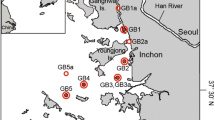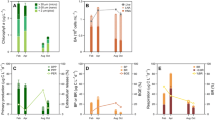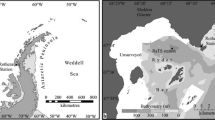Abstract
In pelagic ecosystems, the principal source of organic matter is via autotrophic production and the primary sink is through heterotrophic respiration. One would therefore anticipate that there is some degree of linkage between these two compartments. Recent work has shown that respiration in the light is higher than dark respiration. Consequently, many of the methods used to determine respiration and production are biased as they require the assumption that light and dark respiration rates are equivalent. We show here that, in a coastal ecosystem, under visible light exposure, respiration in the light is related to gross production. More than 60% of the variation of respiration in the light, measured at 1 to 40 µg L−1 of chlorophyll a (Chla), could be explained by the variations of gross production. Secondly, the relative contribution of bacterial respiration to community respiration in the light represented up to 79% at low Chla (1 µg L−1) and was negatively correlated with Chla concentration. Although bacterial production and bacterial respiration were both enhanced in the light, bacterial respiration in the light was more stimulated than bacterial production, which resulted in a decrease in bacterial growth efficiency during light exposure. These results show that the impact of light on the functioning of the microbial loop needs to be taken into account for a better understanding of the oceanic carbon cycle.






Similar content being viewed by others
References
Alonso-Saez L, Gasol JM, Lefort T, Hofer J, Sommaruga R (2006) Effect of natural sunlight on bacterial activity and differential sensitivity of natural bacterioplankton groups in northwestern Mediterranean coastal waters. Appl Environ Microbiol 72:5806–5813
Amon RMW, Fitznar HP, Benner R (2001) Linkages among the bioreactivity, chemical composition, and diagenetic state of marine dissolved organic matter. Limnol Oceanogr 46:287–297
Aristegui J, Harrison WG (2002) Decoupling of primary production and community respiration in the ocean: implications for regional carbon studies. Aquat Microb Ecol 29:199–209
Beardall J, Burger-Wiersma T, Rijkeboer M, Sukenik A, Lemoalle J, Dubinsky Z, Fontvielle D (1994) Studies on enhanced post-illumination respiration in microalgae. J Plankton Res 16:1401–1410
Bettarel Y, Dolan JR, Hornak K, Lemee R, Masin M, Pedrotti ML, Rochelle-Newall E, Simek K, Sime-Ngando T (2002) Strong, weak, and missing links in a microbial community of the NW Mediterranean Sea. FEMS Microbiol Ecol 42:451–462
Biddanda B, Benner R (1997) Carbon, nitrogen, and carbohydrate fluxes during the production of particulate and dissolved organic matter by marine phytoplankton. Limnol Oceanogr 42:506–518
Biddanda B, Ogdahl M, Cotner J (2001) Dominance of bacterial metabolism in oligotrophic relative to eutrophic waters. Limnol Oceanogr 46:730–739
Biersmith A, Benner R (1998) Carbohydrates in phytoplankton and freshly produced dissolved organic matter. Mar Chem 63:131–144
Briand E, Pringault O, Jacquet S, Torreton JP (2004) The use of oxygen microprobes to measure bacterial respiration for determining bacterioplankton growth efficiency. Limnol Oceanogr-Meth 2:406–416
Canfield DE, Des Marais DJ (1993) Biogeochemical cycles of carbon, sulfur, and free oxygen in microbial mat. Geochim Cosmochim Acta 57:3971–3984
Chen WH, Wangersky PJ (1996) Rates of microbial degradation of dissolved organic carbon from phytoplankton cultures. J Plank Res 18:1521–1533
Cherrier J, Bauer JE (2004) Bacterial utilization of transient plankton-derived dissolved organic carbon and nitrogen inputs in surface ocean waters. Aquat Microb Ecol 35:229–241
Church MJ, Ducklow HW, Karl DM (2004) Light dependence of [3H]leucine incorporation in the oligotrophic North Pacific Ocean. Appl Environ Microbiol 70:4079–4087
Coffin R, Connolly J, Harris P (1993) Availability of dissolved organic carbon to bacterioplankton examined by oxygen utilization. Mar Ecol Prog Ser 101:9–22
Cole J, Findlay S, Pace ML (1988) Bacterial production in fresh and saltwater ecosystems: a cross-system overview. Mar Ecol Prog Ser 43:1–10
Cotner JB, Biddanda BA (2002) Small players, large role: microbial influence on biogeochemical processes in pelagic aquatic ecosystems. Ecosystems 5:105–121
Cottrell M, Michelou V, Nemcek N, DiTullio G, Kirchman DL (2008) Carbon cycling by microbes influenced by light in the Northeast Atlantic Ocean. Aquat Microb Ecol 50:239–250
del Giorgio PA, Cole JJ (1998) Bacterial growth efficiency in natural aquatic systems. Annu Rev Ecol Syst 29:503–541
del Giorgio PA, Gasol JM, Vaque D, Mura P, Agusti S, Duarte CM (1996) Bacterioplankton community structure: protists control net production and the proportion of active bacteria in a coastal marine community. Limnol Oceanogr 41:1169–1179
Ekelund NGA (2000) Interactions between photosynthesis and ‘light-enhanced dark respiration’ (LEDR) in the flagellate Euglena gracilis after irradiation with ultraviolet radiation. J Photochem Photobiol B: Biol 55:63–69
Falkowski PG, Dubinsky Z, Santostefano G (1985) Light-enhanced dark respiration in phytoplankton. Verh Internat Verein Limnol 22:2830–2833
Gattuso J, Peduzzi S, Pizay M-D, Tonolla M (2002) Changes in freshwater bacterial community composition during measurements of microbial and community respiration. J Plank Res 24:1197–1206
Gaudy R, Le Borgne R, Landry MR, Champalbert G (2004) Biomass, feeding and metabolism of mesozooplankton in the equatorial Pacific along 180 degrees. Deep Sea Research Part II: Topical Studies in Oceanography 51:629–645
Grande KD, Marra J, Langdon C, Heinemann K, Bender ML (1989) Rates of respiration in the light measured in marine phytoplankton using an 18O isotope-labelling technique. J Exp Mar Biol Ecol 129:95–120
Grande KD, Williams PJleB, Marra J, Purdie DA, Heinemann K, Eppley RW, Bender ML (1989) Primary production in the North Pacific gyre: a comparison of rates determined by the 14C, O2 concentration and 18O methods. Deep Sea Res 36:1621–1634
Granum E, Kirkvold S, Myklestad SM (2002) Cellular and extracellular production of carbohydrates and amino acids by the marine diatom Skeletonema costatum: diel variations and effects of N depletion. Mar Ecol Prog Ser 242:83–94
Guillard RRL (2005) Purification methods for microalgae. In: Andersen RA (ed) Algal culturing techniques. Elsevier, San Diego, pp 117–132
Hagström Å, Pinhassi J, Zweifel UL (2001) Marine bacterioplankton show burst of rapid growth induced by substrate shifts. Aquat Microb Ecol 24:109–115
Hamdan LJ, Jonas RB (2007) The use of antibiotics to reduce bacterioplankton uptake of phytoplankton extracellular organic carbon (EOC) in the Potomac River estuary. J Exp Mar Biol Ecol 342:242–252
Heraud P, Beardall J (2002) Ultraviolet radiation has no effect on respiratory oxygen consumption or enhanced post-illumination respiration in three species of microalgae. J Photochem Photobiol B: Biol 68:109–116
Hernandez KL, Quinones RA, Daneri G, Farias ME, Helbling EW (2007) Solar UV radiation modulates daily production and DNA damage of marine bacterioplankton from a productive upwelling zone (36 degrees S), Chile. J Exp Mar Biol Ecol 343:82–95
Hernandez KL, Quinones RA, Daneri G, Helbling EW (2006) Effects of solar radiation on bacterioplankton production in the upwelling system off central-southern Chile. Mar Ecol Prog Ser 315:19–31
Holm-Hansen O, Lorenzen CJ, Holmes RW, Strickland JDH (1965) Fluorimetric determination of chlorophyll. Rapp P-V Reun Cons Int Explor Mer 30:3–15
Hooker SB, Van Heukelem L, Thomas CS, Claustre H, Ras J, Barlow RG, Sessions H (2005) The second seaWiFS HPLC analysis round-robin experiment (SeaHARRE-2) NASA/TM-2005-212785. National Aeronautics and Space Administration. 124 pages
Jacquet S, Delesalle B, Torreton JP, Blanchot J (2006) Response of phytoplankton communities to increased anthropogenic influences (southwestern lagoon, New Caledonia). Mar Ecol Prog Ser 320:65–78
Jahnke RA, Craven DB (1995) Quantifying the role of heterotrophic bacteria in the carbon cycle: a need for respiration rate measurements. Limnol Oceanogr 40:436–441
Jassby AD, Platt T (1976) Mathematical formulation of the relationship between photosynthesis and light for phytoplankton. Limnol Oceanogr 21:540–547
Johnson W, Lewitus AJ, Fletcher M (2006) Linking bacterioplankton community structures to environmental state variables and phytoplankton assemblages in two South Carolina salt marsh estuaries. Aquat Microb Ecol 45:129–145
Kirchman DL (2001) Measuring bacterial biomass production and growth rates from leucine incorporation in natural aquatic environments. Meth Microbiol 30:227–237
Kirchman DL, Sigda L, Kapuscinski R, Mitchell R (1982) Statistical analysis of the direct count method for enumerating bacteria. Appl Environ Microbiol 44:376–382
Kirk JTO (1994) Light and photosynthesis in aquatic ecosystems. Cambridge University Press, Cambridge
Lemée R, Rochelle-Newall E, Van Wambeke F, Pizay MD, Rinaldi P, Gattuso JP (2002) Seasonal variation of bacterial production, respiration and growth efficiency in the open NW Mediterranean Sea. Aquat Microb Ecol 29:227–237
Luz B, Barkan E, Sagi Y, Yacobi YZ (2002) Evaluation of community respiratory mechanisms with oxygen isotopes: a case study in Lake Kinneret. Limnol Oceanogr 47:33–42
Mary I, Tarran GA, Warwick PE, Terry MJ, Scanlan DJ, Burkill PH, Zubkov MV (2008) Light enhanced amino acid uptake by dominant bacterioplankton groups in surface waters of the Atlantic Ocean. FEMS Microbiol Ecol 63:36–45
Morán XAG, Estrada M, Gasol JM, Pedros-Alio C (2002) Dissolved primary production and the strength of phytoplankton bacterioplankton coupling in contrasting marine regions. Microb Ecol 44:217–223
Morán XAG, Massana R, Gasol JM (2001) Light conditions affect the measurement of oceanic bacterial production via leucine uptake. Appl Environ Microbiol 67:3795–3801
Noble PA, Tymowski RG, Fletcher M, Morris JT, Lewitus AJ (2003) Contrasting patterns of phytoplankton community pigment composition in two salt marsh estuaries in southeastern United States. Appl Environ Microbiol 69:4129–4143
Oremland RS, Capone DG (1988) Use of specific inhibitors in biogeochemistry and microbial ecology. Adv Microb Ecol 10:285–383
Pakulski JD, Aas P, Jeffrey W, Lyons M, Von Waasenbergen L, Mitchell D, Coffin R (1998) Influence of light on bacterioplankton production and respiration in a subtropical coral reef. Aquat Microb Ecol 14:137–148
Pomeroy L, Sheldon J, Sheldon W, Peters F (1995) Limits to growth and respiration of bacterioplankton in the Gulf of Mexico. Mar Ecol Prog Ser 117:259–268
Pomeroy LR, Wiebe WJ (2001) Temperature and substrates as interactive limiting factors for marine heterotrophic bacteria. Aquat Microb Ecol 23:187–204
Pringault O, de Wit R, Camoin G (2005) Irradiance regulation of photosynthesis and respiration in modern marine microbialites built by benthic cyanobacteria in a tropical lagoon (New Caledonia). Microb Ecol 49:604–616
Pringault O, Tassas V, Rochelle-Newall E (2007) Consequences of respiration in the determination of production in pelagic systems. Biogeosciences 4:105–114
Raven JA, Beardall J (2005) Respiration in aquatic photolithotrophs. In: del Giorgio PA, Williams PJleB (eds) Respiration in aquatic ecosystems. Oxford University Press, New York, pp 36–46
Reinthaler T, Herndl GJ (2005) Seasonal dynamics of bacterial growth efficiencies in relation to phytoplankton in the southern North Sea. Aquat Microb Ecol 39:7–16
Renaud F, Pringault O, Rochelle-Newall E (2005) Effects of the colonial cyanobacterium Trichodesmium spp. on bacterial activity. Aquat Microb Ecol 41:261–270
Revsbech NP (1989) An oxygen microsensor with a guard cathode. Limnol Oceanogr 34:474–476
Riemann B, Nielsen P, Jeppesen M, Marcussen B, Fuhrman JA (1984) Diel changes in bacterial biomass and growth-rates in coastal environments, determined by means of thymidine incorporation into DNA, frequency of dividing cells (FDC), and microautoradiography. Mar Ecol Prog Ser 17:227–235
Roberts BJ, Howarth RW (2006) Nutrient and light availability regulate the relative contribution of autotrophs and heterotrophs to respiration in freshwater pelagic ecosystems. Limnol Oceanogr 51:288–298
Robinson C, Williams PJleB (2005) Respiration and its measurement in surface marine waters. In: del Giorgio PA, Williams PJleB (eds) Respiration in aquatic ecosystems. Oxford University Press, New York, pp 147–180
Rochelle-Newall E, Torreton JP, Mari X, Pringault O (2008) Phytoplankton–bacterioplankton coupling in a sub-tropical South Pacific coral reef lagoon. Aquat Microb Ecol 50:221–229
Rochelle-Newall E, Winter C, Barron C, Borges AV, Duarte CM, Elliott M, Frankignoulle M, Gazeau F, Middelburg JJ, Pizay MD, Gattuso JP (2007) Artificial neural network analysis of factors controlling ecosystem metabolism in coastal systems. Ecol Appl 17:185–196
Sherr BF, Sherr EB, Andrew TL, Fallon RD, Newell SY (1986) Trophic interactions between heterotrophic protozoa and bacterioplankton in estuarine water analyzes with selective metabolic inhibitors. Mar Ecol Prog Ser 32:169–179
Shiah FK (1999) Diel cycles of heterotrophic bacterioplankton abundance and production in the ocean surface waters. Aquat Microb Ecol 17:239–246
Smith DC, Azam F (1992) A simple, economical method for measuring bacterial protein synthesis rates in seawater using [3H]-leucine. Mar Microb Food Webs 6:107–114
Tranvik LJ, Bertilsson S (2001) Contrasting effects of solar UV radiation on dissolved organic sources for bacterial growth. Ecol Lett 4:458–463
Van Heukelem L, Thomas CS (2001) Computer-assisted high-performance liquid chromatography method development with applications to the isolation and analysis of phytoplankton pigments. J Chromatogr A 910:31–49
Veuger B, Middelburg JJ, Boschker HTS, Nieuwenhuize J, van Rijswijk P, Rochelle-Newall EJ, Navarro N (2004) Microbial uptake of dissolved organic and inorganic nitrogen in Randers Fjord. Estuar Coast Shelf Sci 61:507–515
Visser PM, Snelder E, Kop AJ, Boelen P, Buma AGJ, van Duyl FC (1999) Effects of UV radiation on DNA photodamage and production in bacterioplankton in the coastal Caribbean Sea. Aquat Microb Ecol 20:49–58
Weger HG, Herzig R, Falkowski PG, Turpin DH (1989) Respiratory losses in the light in a marine diatom: measurements by short-term mass spectrometry. Limnol Oceanogr 34:1153–1161
Wikner J, Rassoulzadegan F, Hagstrom A (1990) Periodic bacterivore activity balances bacterial growth in the marine environment. Limnol Oceanogr 35:313–324
Williams PJleB, Yentsch CS (1976) Examination of photosynthetic production, excretion of photosynthetic products, and heterotrophic utilization of dissolved organic-compounds with reference to results from a coastal subtropical sea. Mar Biol 35:31–40
Xue X, Gauthier DA, Turpin DH, Weger HG (1996) Interactions between photosynthesis and respiration in the green alga Chlamydomonas reinhardtii (characterization of light-enhanced dark respiration). Plant Physiol 112:1005–1014
Acknowledgments
This work was supported by the French Institute for Research for Development (IRD), by the French national program of coastal environment (PNEC), by the national program of ecotoxicology (PNETOX), and by the French Ministry of Overseas Territories (MOM). We would like to thank P.J. le B. Williams and three anonymous reviewers for their comments which greatly improved the quality of the manuscript.
Author information
Authors and Affiliations
Corresponding author
Rights and permissions
About this article
Cite this article
Pringault, O., Tesson, S. & Rochelle-Newall, E. Respiration in the Light and Bacterio-Phytoplankton Coupling in a Coastal Environment. Microb Ecol 57, 321–334 (2009). https://doi.org/10.1007/s00248-008-9422-7
Received:
Accepted:
Published:
Issue Date:
DOI: https://doi.org/10.1007/s00248-008-9422-7




